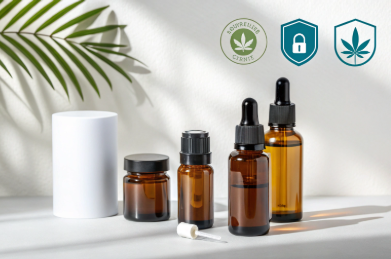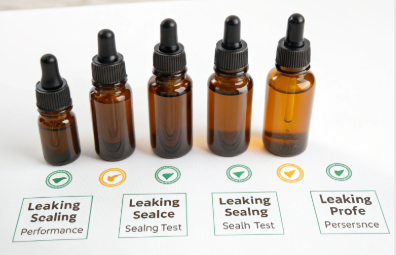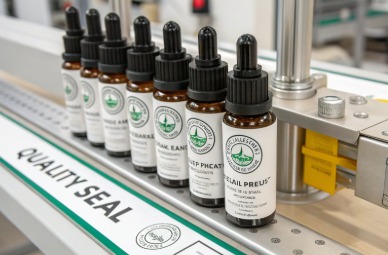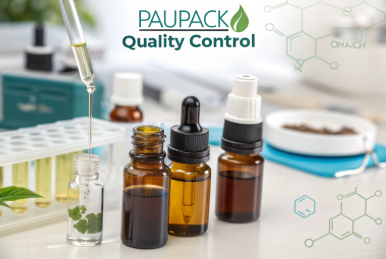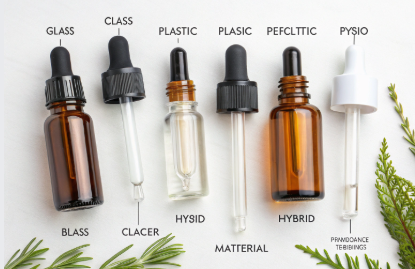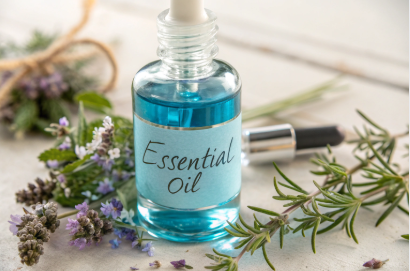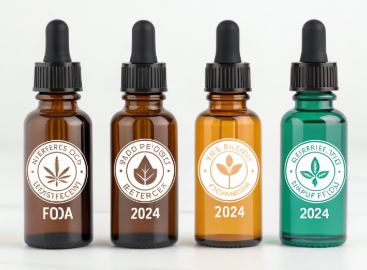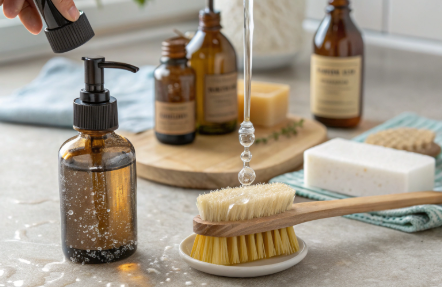One leak can destroy a customer’s trust—and your product’s shelf appeal.
In our comparative leakage test of 10 global essential oil bottle suppliers, sealing performance varied dramatically, with only four passing all tests under pressure, tilt, and temperature fluctuations.
Leak prevention isn’t optional—it’s the foundation of premium packaging.
Why Leakage Prevention Is Critical in Essential Oil Packaging?
Essential oils are potent, reactive, and often expensive. A faulty seal can mean ruined product, safety risks, and brand damage.
Leakage in essential oil packaging leads to product loss, skin irritation risks, regulatory recalls, and poor unboxing experiences.
It’s especially critical in:
-
Glass dropper bottles where oils can seep through imperfect threads
-
Roller bottles used on-the-go or in bags
-
Spray bottles used in home and spa environments
At PauPack, we design all our essential oil bottles to pass 5 key leakage resistance tests: tilt, inversion, thermal expansion, altitude simulation, and drop test.
How Did 10 Leading Suppliers Perform in Leakage Stress Tests?
We conducted a standardized leakage test comparing 10 suppliers across China, the U.S., and Europe, using their best-selling 15ml and 30ml essential oil bottles.
Only 4 out of 10 suppliers passed all tests, while others showed minor seepage or full failure under heat or inverted storage.
Test Method Summary
| Test Type | Description |
|---|---|
| Tilt Test | Bottles stored at 45° for 72h |
| Inversion Test | Full bottle upside down, 24h |
| Thermal Test | Exposed to 40°C for 48h |
| Drop Test | Dropped 3 times from 1.2m |
| Flight Simulation | Pressure drop chamber test |
Results Overview
| Supplier | Passed All Tests? | Notes |
|---|---|---|
| PauPack | ✅ | Excellent seal + neck finish consistency |
| Supplier B | ✅ | Minor aesthetic flaws |
| Supplier C | ✅ | Strong dropper retention |
| Supplier D | ✅ | Roller cap required double insertion |
| Supplier E–J | ❌ | Leakage in heat/inversion/drop tests |
The clear lesson: don’t judge a bottle by its look—test it before you trust it.
What Design Factors Most Influence Leak Resistance?
A bottle’s shape or glass quality means nothing if the closure system fails.
Leak resistance is determined by how well the bottle neck, cap, liner, and dispensing mechanism work together under real-world stress.
Key Design Variables
| Factor | Influence |
|---|---|
| Neck precision | Tighter tolerances = less oil seepage |
| Cap liner material | TPE, silicone, or foam—each behaves differently under heat |
| Thread fit | Misalignment = micro gaps |
| Dropper/roller/spray interface | Moving parts often fail if poorly molded |
| Material compatibility | Some essential oils degrade rubber or glue over time |
At PauPack, our CR dropper and roller bottles use precision-ground necks, lab-tested liners, and low-expansion materials to ensure no leakage during transport, storage, or use.
How PauPack Achieves Consistent Sealing for Global Brands?
Leak-proofing isn’t a one-time fix—it’s a systems-level discipline.
At PauPack, every essential oil bottle undergoes triple-stage QC: mold inspection, torque testing, and final product simulation.
Our Quality Control Steps:
-
Neck calibration checked via digital gauges
-
Torque testing for dropper/spray closure strength
-
Temperature chamber validation (−10°C to +50°C)
-
Batch sampling for every 3000 pcs
-
Custom-fit liners selected based on oil type
We also offer:
-
Leak-resistant packaging mockups (including insert + box)
-
Compatibility tests for client oil formulations
-
Sealing guarantees backed by ISO 9001 and FDA-level QA
That’s why we’re trusted by over 100 aromatherapy and skincare brands in 52+ countries.
How to Select Leak-proof Bottles for Your 2025 Product Line?
The safest bottle is the one you test early—and the one your supplier stands behind.
To ensure leak-proof performance in 2025, brands should demand validated samples, request full test reports, and understand how packaging will behave in transit and real usage.
Your Leak-proof Selection Checklist
| Step | Action |
|---|---|
| Sample multiple caps per bottle | Test for repeatability |
| Request inverted + heat test results | Don’t settle for room-temp proof |
| Match cap/liner to oil formulation | Citrus oils need extra care |
| Ask for torque specs | Prevent user over-tightening or leaks |
| Use PauPack drop test & flight simulation | Available on request for OEM projects |
PauPack also helps you create starter test kits with pre-filled samples—ready for your QA team, investors, or pilot users to assess sealing before full production.
What Causes Leakage in Essential Oil Bottles During Transit?
Shipping conditions are rarely ideal. Bottles are stacked, shaken, and exposed to fluctuating temperatures.
Leakage during transit is typically caused by poor sealing design, thermal expansion, weak liner materials, or incompatible closures under pressure.
Main Transit-related Leakage Causes
| Cause | Description |
|---|---|
| Cap loosened by vibration | Torque loss during bumpy transport |
| Heat expansion | Essential oils increase pressure at high temps |
| Thin or warped liners | Inconsistent sealing surface inside the cap |
| Dropper bulb absorption | Oils degrade or leak through natural rubber |
| Incorrect neck-thread pairing | Slight mismatch = microgaps = seepage |
At PauPack, we simulate transport using vibration tables, thermal chambers, and inverted stack stress to ensure every bottle leaves our warehouse leak-resistant.
Why Many Suppliers Still Fail Real-world Leakage Tests?
Most factories only test bottles in ideal, upright, room-temperature conditions.
But essential oil bottles face real-world chaos—being shipped across continents, stored in humid warehouses, or tossed into a purse or suitcase.
Here’s where most suppliers go wrong:
-
No drop/inversion testing
-
Low-cost liners with no compatibility verification
-
Cap tightening done manually without torque calibration
-
Inconsistent neck finish due to mold degradation
-
No packaging interaction testing (e.g., dropper + cap + label shrink film)
At PauPack, we build leakage testing into our QC SOP—not as a marketing claim, but as a product standard.
How Leakage Impacts Product Quality, Reviews, and Returns?
The damage from one leaky bottle isn’t just the oil—it’s your entire customer experience.
Leakage can stain boxes, trigger returns, destroy shelf display, and cause negative reviews, especially in wellness markets where product purity and packaging are perceived as part of the value.
Business Risks of Packaging Leaks
| Impact | Example |
|---|---|
| Amazon FBA rejection | Label damage, leaking liquid not allowed |
| Negative reviews | "Smelled great but leaked all over the box" |
| High return rate | Fragile reputation with new customers |
| Retailer penalties | Shelf damage or cross-contamination |
| Regulatory recall | For flammable or reactive oils (e.g., eucalyptus, citrus) |
PauPack clients reduce return rates by up to 70% after switching to our precision-engineered dropper bottles. It’s not just what you sell—it’s how safely it arrives.
How PauPack Designs Leak-proof Packaging for Complex Oils?
Essential oils aren’t water—they’re volatile, reactive, and often temperature-sensitive.
We engineer each bottle and closure set to withstand pressure, movement, and time—even for citrus, camphor, or alcohol-based blends.
PauPack Anti-Leakage Design Features
| Feature | Benefit |
|---|---|
| Tamper-evident dropper caps | Holds seal even after multiple openings |
| Food-grade TPE liners | Compatible with citrus and herbal oils |
| UV-protected glass necks | Prevent resin breakdown from sun exposure |
| Heat-tested bulb materials | Silicone alternatives to absorbent rubber |
| Thread-matching protocol | ±0.1mm tolerances for zero side-seepage |
We also test all OEM designs using 5-day upright/inverted/angled conditions at 40°C—far beyond typical standards.
How to Audit Suppliers for Leakage Prevention Before You Order?
Preventing leakage starts before production—it starts at supplier vetting.
B2B buyers should audit essential oil packaging vendors not just for design, but for quality consistency, test procedures, and actual shipping simulations.
Leakage-focused Supplier Audit Checklist
| Audit Point | What to Look For |
|---|---|
| Torque testing tools | Are capping machines calibrated? |
| Liner stock traceability | Can they prove material compatibility? |
| Transit testing documentation | Drop/inversion/thermal reports available? |
| Cap-to-bottle matching | Do they test pairs as a system? |
| Pre-shipment leak test protocol | What % of each batch is inspected? |
At PauPack, we invite clients to observe QC procedures, or request video testing of their custom samples before final production. You deserve confidence, not surprises.
Conclusion
Leakage is a silent killer in essential oil packaging—but it’s 100% preventable with smart design and strict testing. PauPack helps you seal the deal—literally and reliably.



